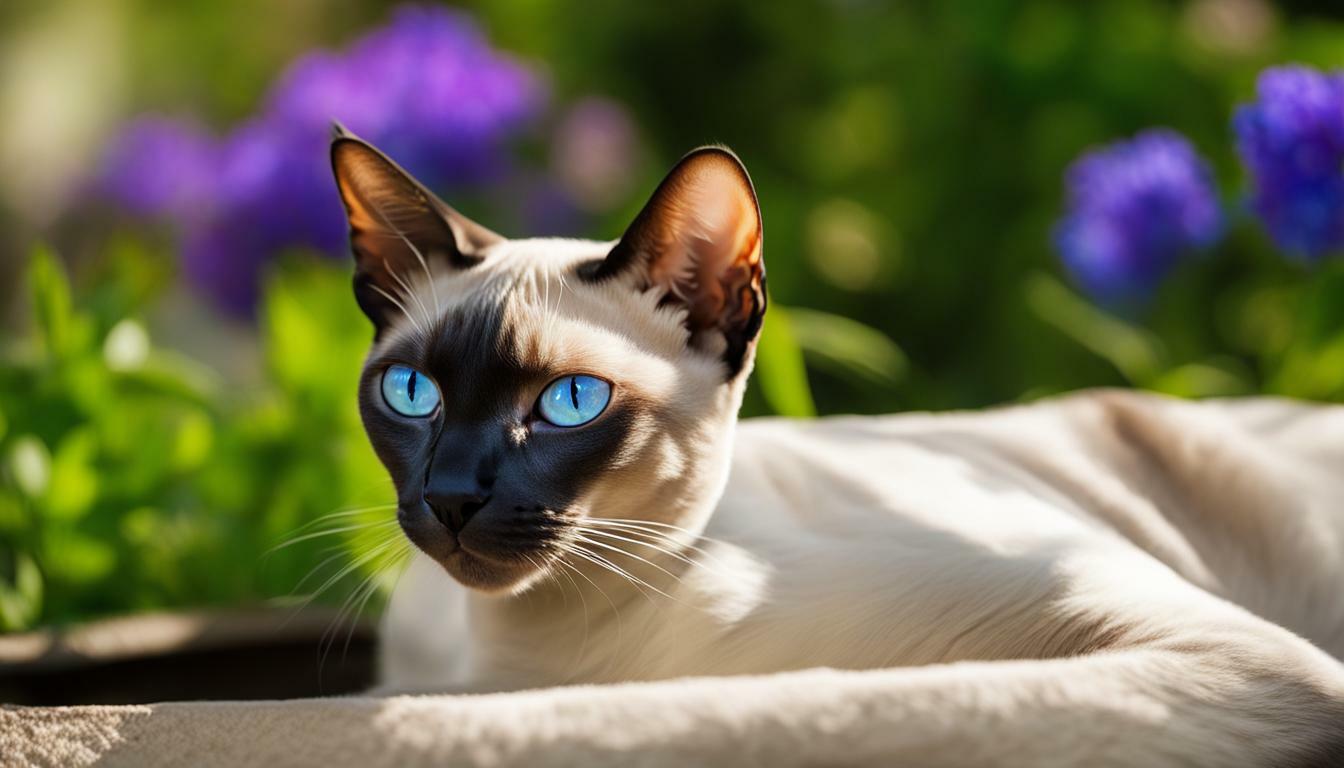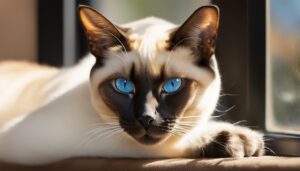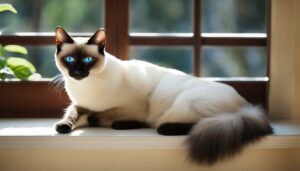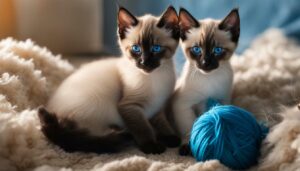The Hairless Siamese Cat, also known as the Sphynx cat, is a unique breed known for its lack of fur. Hairlessness in cats is a naturally occurring genetic mutation, and the Sphynx breed was developed through selective breeding starting in the 1960s. These cats have a narrow, long head, large lemon-shaped eyes, and very large ears. Their skin has the texture of chamois leather, and they may have a fine fuzz or be completely hairless. The breed comes in a variety of colors and patterns. Sphynx cats are known for being extroverted, energetic, and affectionate.
Key Takeaways:
- The Hairless Siamese Cat, also known as the Sphynx cat, is a breed known for its lack of fur.
- Sphynx cats have a narrow, long head, large lemon-shaped eyes, and very large ears.
- Their skin has the texture of chamois leather, and they may have a fine fuzz or be completely hairless.
- Sphynx cats come in a variety of colors and patterns.
- Sphynx cats are extroverted, energetic, and affectionate.
The Origins and Appearance of the Hairless Siamese Cat
The hairless Siamese cat, commonly referred to as the Sphynx cat, has a distinct appearance characterized by its narrow long head, large lemon-shaped eyes, and very large ears. This unique breed originated from a natural genetic mutation that causes hairlessness in cats. While the breed may appear bald, their skin has the texture of chamois leather, and they may have a fine fuzz or be completely hairless.
The Sphynx cat’s distinctive features contribute to its striking appearance. The narrow long head combined with their large lemon-shaped eyes gives them an expressive facial expression that captures attention. Their very large ears, often compared to bat wings, are prominent and add to their overall distinctive look. These characteristics make the hairless Siamese cat easily recognizable and highly sought after by cat enthusiasts.
The origins of the breed can be traced back to the 1960s when selective breeding began to develop cats with the desired hairlessness. Initially, the Sphynx breed faced challenges due to the misconception that hairlessness was indicative of health issues. However, breeders and veterinarians have worked diligently to dispel these myths, and the Sphynx cat is now recognized as a healthy and unique breed with a devoted following.
The Origins and Appearance of the Hairless Siamese Cat
“The hairless Siamese cat, commonly referred to as the Sphynx cat, has a distinct appearance characterized by its narrow long head, large lemon-shaped eyes, and very large ears.”
As the Sphynx cat continues to captivate people with its unusual looks, the breed has expanded to include a variety of colors and patterns. These cats can be found in solid colors, as well as patterns such as tabby, tortoiseshell, and pointed. This diversity adds to the charm and individuality of each hairless Siamese cat.
The hairless Siamese cat’s unique appearance is not the only aspect that sets them apart. Their personality and temperament also contribute to their appeal. Sphynx cats are known for being extroverted, energetic, and affectionate. They enjoy interacting with their human companions and thrive on attention and playtime. Their playful nature and loving demeanor make them wonderful companions for those looking for an engaging and affectionate feline friend.
| Appearance | Personality | Care Needs |
|---|---|---|
| Narrow long head | Extroverted | Regular bathing |
| Large lemon-shaped eyes | Energetic | Sunlight and cold temperature protection |
| Very large ears | Affectionate | Ears and nails cleaning |
To keep a hairless Siamese cat happy and healthy, regular bathing is essential to remove oils from their skin. Additionally, they require protection from direct sunlight and cold temperatures due to their lack of fur. It is important to clean their ears and nails regularly to maintain their hygiene. While the Sphynx breed can live for 8 to 14 years, it is crucial to provide them with proper care and attention to ensure their well-being.
In conclusion, the hairless Siamese cat, or Sphynx cat, is a unique and fascinating breed that captivates with its distinctive appearance and lively personality. Despite their lack of fur, these cats are full of energy, love, and playfulness. Their care needs may differ from other breeds, but with the right knowledge and dedication, they can make wonderful and loyal companions.
Colors and Patterns of the Hairless Siamese Cat
Hairless Siamese cats come in a variety of colors and patterns, adding to their unique and captivating appeal. Despite their lack of fur, their skin showcases an array of beautiful hues, making each Sphynx cat truly one-of-a-kind. Let’s explore the stunning colors and patterns that these hairless felines can boast.
Colors:
The hairless Siamese cat breed can exhibit a wide range of colors. From elegant shades of white and cream to bold tones like black and gray, their skin acts as a canvas for an artist’s palette. These cats can also display rich, warm colors like caramel, chocolate, and cinnamon. With such a diverse color spectrum, there is undoubtedly a hairless Siamese cat to suit every personal preference.
Patterns:
In addition to their captivating colors, hairless Siamese cats can also showcase various patterns that enhance their unique appearance. Some Sphynx cats exhibit solid patterns where their skin is uniform in color throughout their body. Others may sport striking patterns such as mottled or tabby. These patterns can create beautiful contrasts and make each hairless Siamese cat visually stunning in its own way.
Whether you prefer a hairless Siamese cat with a solid coat of color or one with an intricate pattern, the variety within this breed ensures that you’ll find a feline companion that matches your aesthetic preferences.
| Color | Pattern |
|---|---|
| White | Solid |
| Black | Mottled |
| Caramel | Tabby |
The Personality and Temperament of the Hairless Siamese Cat
Hairless Siamese cats are renowned for their extroverted nature, boundless energy, and affectionate disposition. These unique feline companions thrive on social interaction and love being the center of attention. They are not your typical lap cats; instead, they prefer to be actively involved in every aspect of your daily life. Whether you’re cooking in the kitchen, working on your computer, or watching TV, you can count on your hairless Siamese cat to be right by your side, curious about everything you do.
With their energetic personalities, these cats love to play and explore. They enjoy interactive toys, puzzle games, and climbing structures that provide mental and physical stimulation. Their agile nature allows them to jump, run, and climb with ease. You’ll often find them chasing after toys or playfully swatting at objects that catch their attention. It’s important to provide them with plenty of playtime and exercise to keep them happy and prevent boredom, as they can become mischievous if not adequately stimulated.
Aside from their playful side, hairless Siamese cats are also incredibly affectionate. They form strong bonds with their owners and crave constant companionship. Expect them to cuddle up next to you at night, nuzzle against your legs, or gently tap you for attention. These cats thrive on human touch and love being petted and stroked. Their warm, velvety skin makes them irresistible to touch, and their purrs will fill the room as they bask in your affection.
| Personality Traits | Description |
|---|---|
| Extroverted | Hairless Siamese cats are social butterflies who enjoy being around people and other pets. |
| Energetic | These cats have a natural zest for life and require ample playtime to keep them stimulated and happy. |
| Affectionate | They form deep bonds with their owners and thrive on love and attention. |
Living with a hairless Siamese cat is an experience like no other. Their unique appearance might catch your eye, but it’s their playful and loving personalities that will truly capture your heart. With their extroverted nature, boundless energy, and affectionate disposition, these cats make wonderful companions for those looking for an interactive and devoted feline friend.
Care and Grooming for Hairless Siamese Cats
Proper care and grooming are essential for maintaining the health and well-being of hairless Siamese cats. Due to their lack of fur, these cats require special attention to keep their skin clean and healthy. Regular bathing is necessary to remove oils from their skin and prevent buildup that can lead to skin issues. It’s important to use a gentle, hypoallergenic shampoo specifically formulated for cats to avoid any irritation or allergies. When bathing your hairless Siamese cat, ensure the water is warm, but not hot, and be gentle while handling their delicate skin.
In addition to bathing, hairless Siamese cats need protection from sunlight and cold temperatures. Their lack of fur leaves their skin vulnerable to sunburn, so it’s crucial to keep them indoors during peak sun hours and provide them with a safe, shaded area if they spend time outdoors. Extreme temperatures can also be challenging for hairless cats, so it’s essential to keep them warm during colder months. Provide them with cozy blankets and consider investing in a cat sweater or a heated bed to help regulate their body temperature.
“Regular bathing is necessary to remove oils from their skin and prevent buildup that can lead to skin issues.”
To maintain good hygiene, it’s important to clean the ears and trim the nails of hairless Siamese cats regularly. Their big ears can accumulate wax and debris, which can lead to infections if left unattended. Gently clean their ears with a damp cotton ball or a specially formulated ear cleaner recommended by your veterinarian. Trimming their nails is also important to prevent them from becoming too long and causing discomfort or injury. Use cat-specific nail clippers and be cautious not to cut too close to the quick, which can cause bleeding and pain.
Lastly, it’s crucial to provide a balanced diet and regular veterinary care for your hairless Siamese cat. A proper diet will support their overall health and help maintain their skin’s condition. Consult with your veterinarian to determine the appropriate food and feeding schedule for your cat. Regular check-ups with the veterinarian are essential to monitor their health, address any concerns, and ensure they are up to date on vaccinations and preventative treatments for parasites.
| Grooming Tips for Hairless Siamese Cats |
|---|
| 1. Bathe your cat regularly using a gentle, hypoallergenic shampoo. |
| 2. Protect your cat from the sun by keeping them indoors during peak hours and providing shaded areas. |
| 3. Keep your cat warm during colder months with blankets or a heated bed. |
| 4. Clean your cat’s ears regularly with a damp cotton ball or an ear cleaner recommended by your vet. |
| 5. Trim your cat’s nails regularly to prevent them from becoming too long. |
| 6. Provide a balanced diet and regular veterinary care for your cat’s overall health. |
Health and Lifespan of the Hairless Siamese Cat
Hairless Siamese cats, like all cat breeds, may have specific health concerns and generally have an average lifespan of 8 to 14 years.
While the hairless Siamese cat is generally a healthy breed, there are a few health issues that potential owners should be aware of. These concerns include:
- Kidney disease: Hairless Siamese cats may be more prone to developing kidney disease, so regular check-ups and a balanced diet are essential to maintaining their kidney health.
- Heart conditions: Some hairless Siamese cats may be at risk for hypertrophic cardiomyopathy, a condition that causes the heart’s muscles to thicken. Regular heart screenings can help detect and manage any heart-related issues.
- Respiratory problems: Due to their lack of fur, hairless Siamese cats can be more sensitive to temperature changes and may be at a higher risk for respiratory infections. It’s important to keep them warm and protected from extreme weather conditions.
Proper care and regular veterinary check-ups can help prevent and manage these health concerns. Additionally, a nutritious diet, regular exercise, and a stress-free environment can contribute to the overall well-being and longevity of hairless Siamese cats.
Remember, every cat is unique, and individual cats may vary in their specific health needs and lifespan. It’s crucial to consult with a veterinarian for personalized advice and care recommendations for your hairless Siamese cat.
| Common Health Concerns | Average Lifespan |
|---|---|
| Kidney disease | 8-14 years |
| Heart conditions | 8-14 years |
| Respiratory problems | 8-14 years |
Finding Your Hairless Siamese Cat Companion
If you’re considering adding a hairless Siamese cat to your family, it’s important to explore adoption options, understand the costs involved, and gather all the necessary information about the breed.
Adopting a hairless Siamese cat can be a wonderful way to give a loving home to a cat in need. Many rescue organizations and shelters have hairless cats available for adoption. These cats may have been surrendered by their previous owners or found as strays. By adopting, you not only provide a forever home for a cat, but you also support the efforts of these organizations to rescue and care for animals in need.
When it comes to the cost of adopting a hairless Siamese cat, it’s important to note that they tend to be more expensive than other cat breeds. This is due to the breed’s rarity and the specialized care they require. The price can vary depending on factors such as age, lineage, and location. It’s recommended to do thorough research and compare prices from reputable breeders or adoption agencies to ensure you’re getting a fair deal.
Prior to bringing a hairless Siamese cat into your home, it’s crucial to gather all the necessary information about the breed. Learn about their specific needs, such as their grooming requirements, dietary preferences, and any potential health issues that may arise. Understanding the breed’s unique characteristics and temperament will help you provide the best care and environment for your new feline friend.
| Adoption Options | Average Cost | Important Information |
|---|---|---|
| Rescue Organizations | Varies (typically lower than breeders) | Support animal rescue efforts |
| Breeders | $1,500-$3,000+ | Ensure reputable breeder and bloodline |
| Shelters | Varies (typically lower than breeders) | Provide a loving home to a cat in need |
No matter where you choose to adopt your hairless Siamese cat, remember that they thrive on love and attention. They are highly social animals and should not be left alone for extended periods of time. Make sure your home environment is suitable for their lively and energetic nature. With proper care, these unique companions will bring joy and endless affection to your life.
Conclusion
Hairless Siamese cats, with their unique appearance and loving personalities, make for truly remarkable companions for those who appreciate their charm and are willing to provide the care they require.
The Sphynx breed, also known as the hairless Siamese cat, is a result of selective breeding starting in the 1960s, aimed at maintaining the genetic mutation that causes hairlessness in cats. These cats have a distinctive narrow, long head, large lemon-shaped eyes, and very large ears, all contributing to their striking appearance.
Despite their lack of fur, Sphynx cats have skin with the texture of chamois leather, sometimes accompanied by a fine fuzz. Their unique skin tone showcases a variety of colors and patterns, adding to the diversity within the breed.
With their extroverted nature, high energy levels, and affectionate behavior, hairless Siamese cats are known to be lively and engaging companions. However, their care requirements differ from other feline breeds. Regular bathing is essential to remove oils from their skin. They also need protection from sunlight and cold temperatures, and their ears and nails require regular cleaning.
While hairless Siamese cats can live for 8 to 14 years, it is important to note that they thrive best in calm environments with experienced owners. As indoor cats, they are not suited to being left alone for extended periods of time. Their unique personalities and undeniable charm make them cherished companions for those who are willing to provide the care and attention they deserve.
FAQ
Q: What is a hairless Siamese cat?
A: A hairless Siamese cat, also known as a Sphynx cat, is a breed known for its lack of fur.
Q: How did the hairless Siamese cat breed originate?
A: The hairless Siamese cat breed was developed through selective breeding starting in the 1960s.
Q: What are the characteristics of a hairless Siamese cat?
A: Hairless Siamese cats have a narrow, long head, large lemon-shaped eyes, and very large ears.
Q: What colors and patterns do hairless Siamese cats come in?
A: Hairless Siamese cats come in a variety of colors and patterns.
Q: What is the personality and temperament of a hairless Siamese cat?
A: Hairless Siamese cats are known for being extroverted, energetic, and affectionate.
Q: What care and grooming do hairless Siamese cats require?
A: Hairless Siamese cats require regular bathing to remove oils from their skin and need protection from sunlight and cold temperatures. They also need their ears and nails cleaned regularly.
Q: How long do hairless Siamese cats live?
A: Hairless Siamese cats can live for 8 to 14 years.
Q: Are hairless Siamese cats hypoallergenic?
A: No, hairless Siamese cats are not hypoallergenic.
Q: Who is the hairless Siamese cat breed best suited for?
A: Hairless Siamese cats are best suited for experienced owners in calm environments.



